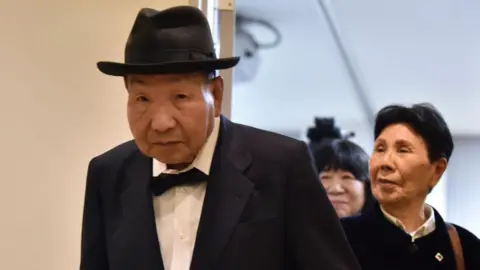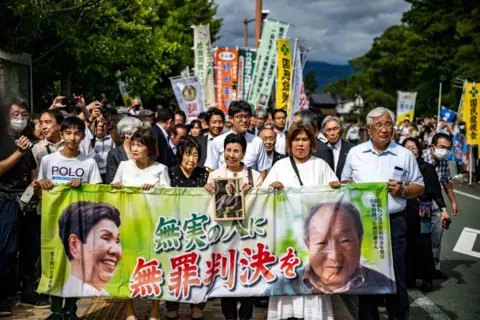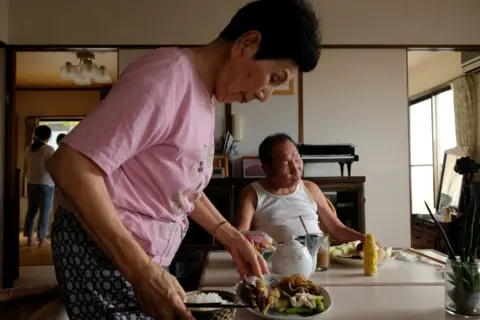 Getty Pictures
Getty PicturesAn 88-year-old man who’s the world’s longest-serving demise row inmate has been acquitted by a Japanese courtroom, after it discovered that proof used towards him was fabricated.
Iwao Hakamada, who has been on demise row for greater than half a century, was discovered responsible in 1968 of killing his boss, the person’s spouse and their two teenage youngsters.
He was just lately granted a retrial amid suspicions that investigators might have planted proof that led to his conviction for quadruple homicide.
Hakamada’s case is one in all Japan’s longest and most well-known authorized sagas.
The case has attracted widespread public curiosity, with some 500 folks lining up for seats within the courtroom in Shizuoka on Thursday.
As the decision was handed down, Hakamada’s supporters outdoors the courtroom cheered “banzai” – a Japanese exclamation which means “hurray”.
Hakamada was not in courtroom, as he had been exempted from all hearings because of his deteriorated psychological state.
He has been dwelling below the care of his sister since 2014, when he was free of jail and granted a retrial.
Bloodstained garments in a tank of miso
A former skilled boxer, Hakamada was working at a miso processing plant in 1966 when the our bodies of his employer, the person’s spouse and two youngsters had been recovered from a hearth at their house in Shizuoka, west of Tokyo. All 4 had been stabbed to demise.
Authorities accused Hakamada of murdering the household, setting hearth to their house and stealing 200,000 yen in money.
Hakamada initially denied having robbed and murdered the victims, however later gave what he got here to explain as a coerced confession following beatings and interrogations that lasted as much as 12 hours a day.
In 1968 he was convicted of homicide and arson, and sentenced to demise.
 Getty Pictures
Getty PicturesThe decades-long authorized saga in the end turned on some bloodstained garments present in a tank of miso a yr after Hakamada’s arrest. These garments had been used to incriminate him.
For years, nevertheless, Hakamada’s legal professionals argued that the DNA recovered from the garments didn’t match his, elevating the likelihood that the objects belonged to another person. The legal professionals additional prompt that police may have fabricated the proof.
Their argument was sufficient to influence Decide Hiroaki Murayama, who in 2014 famous that “the garments weren’t these of the defendant”.
“It’s unjust to detain the defendant additional, as the potential of his innocence has change into clear to a decent diploma,” Murayama stated on the time.
Hakamada was then launched from jail and granted a retrial.
Extended authorized proceedings meant that it took till final yr for that retrial to start – and till Thursday morning for the courtroom to declare the decision.
Whereas the DNA argument was quashed, the choose discovered a brand new argument by defence legal professionals credible – that the crimson stains discovered on the garments couldn’t have been blood, as blood wouldn’t stay crimson on clothes after immersed in miso for a yr.
The choose discovered Hakamada harmless and concluded that the important thing proof introduced by prosecutors was fabricated.
 Getty Pictures
Getty PicturesA long time of detention, principally in solitary confinement with the ever-present menace of execution, have taken a heavy toll on Hakamada’s psychological well being, based on his legal professionals and household.
His 91-year-old sister Hideko has lengthy advocated for his launch. Final yr, when the retrial commenced, she expressed reduction and stated “lastly a weight has been lifted from my shoulders”.
Retrials for demise row inmates are uncommon in Japan – Hakamada’s is simply the fifth in Japan’s post-war historical past.
Together with the US, Japan is the one G7 nation that also imposes capital punishment, with demise row prisoners being notified of their hanging just some hours upfront.




